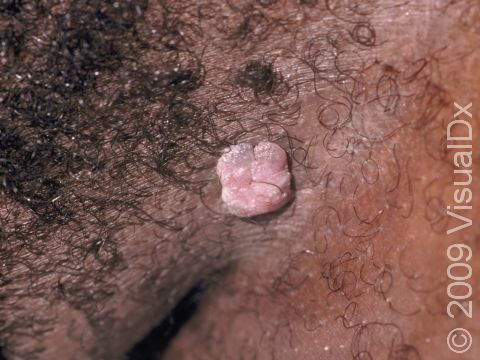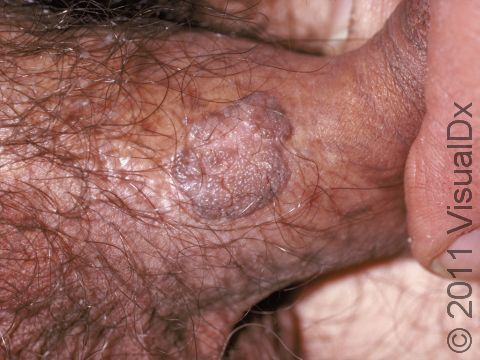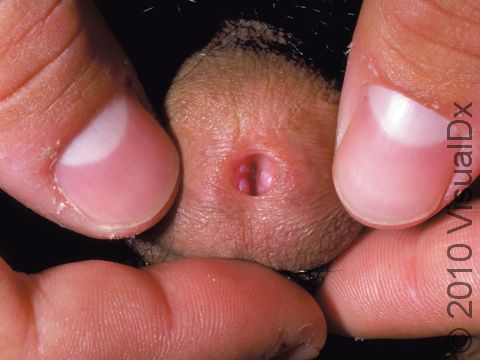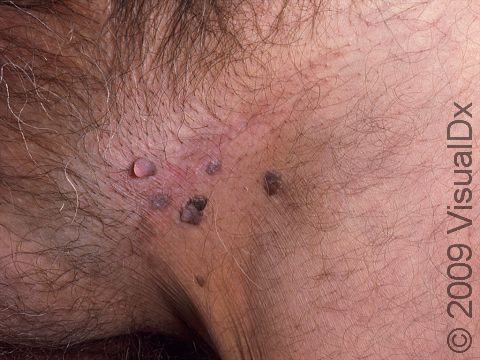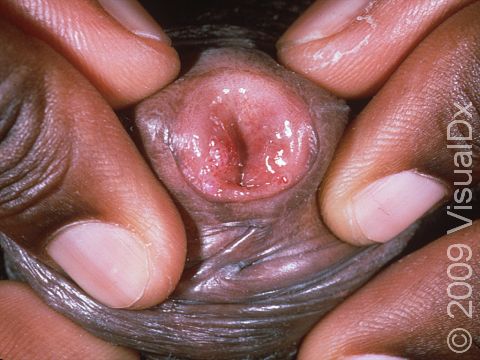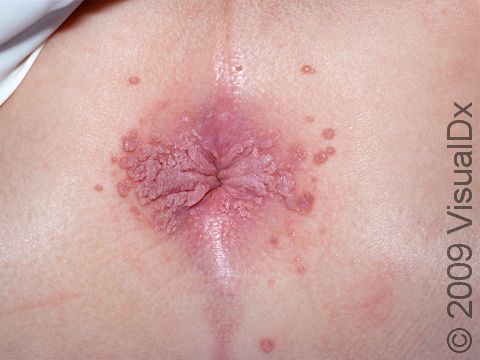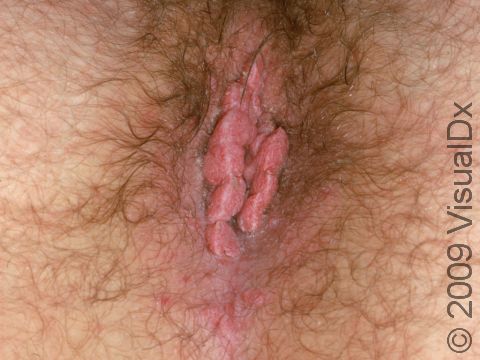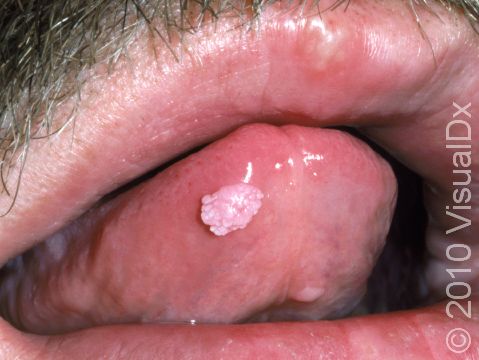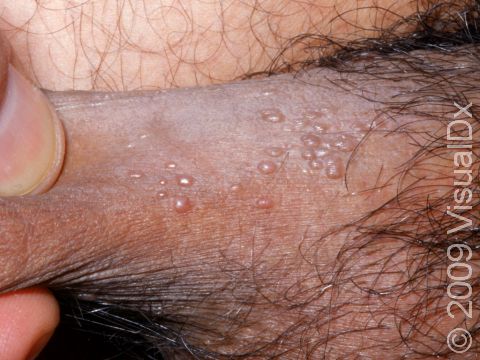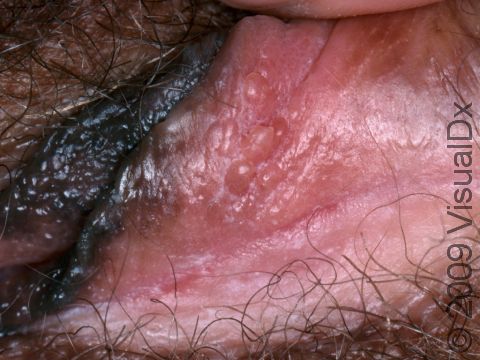Genital Wart (Condyloma Acuminatum)
Genital warts (condyloma acuminata) are caused by the human papillomavirus (HPV), which has over 100 different strains. Subtypes number 6 and 11 cause 90% of genital warts and are considered low risk because they very rarely will cause genital or anal cancer. On the other hand, subtypes 16 and 18, for example, are considered high risk because, although they rarely cause genital warts, they can lead to cervical or anal precancer and cancer.
HPV is spread by skin-to-skin contact during sexual activity; there does not need to be vaginal or anal intercourse to spread the infection. Most people who become infected with HPV will not have symptoms and will clear the infection on their own. For people who do develop genital warts, there are many options for treatment, all of which are meant to remove the visible warts. There is no cure for genital warts.
Gardasil® is a vaccine that protects against the 4 strains of HPV that cause 70% of cervical cancers and 90% of genital warts. In the US, Gardasil is approved for girls/women and boys/men ages 9–26. In 2011, Health Canada approved the vaccine for women up to the age of 45.
Who's At Risk?
Genital warts are the most common sexually transmitted disease and affect millions of people throughout the world. It is estimated that 75–80% of sexually active men and women will be infected with HPV at some point in their lives. Approximately 15% of the United States population is infected with HPV. HPV infection occurs in people of all ages and both sexes. Your risk of acquiring the virus is higher if you have had many sexual partners and if you first had sexual intercourse at a young age. Over 50% of girls will get HPV within 2 years of becoming sexually active.
HPV is spread through skin-to-skin contact and does not require actual intercourse to be passed from one person to another. A person can be infected without any visible signs of infection and, therefore, can pass the infection on without knowing it. Condoms can decrease the risk of spreading the virus, but they do not completely prevent transmission.
Signs & Symptoms
Genital warts appear as flesh-colored, round bumps of varying sizes. They can be smooth and flat or cauliflower-like with a small stalk. They can be seen on the labia, vagina, penis, scrotum, anus, skin around the anus, and urethra. Warts usually do not cause any symptoms, although the warts can bleed and become painful with intercourse if they are located within the vagina.
Self-Care Guidelines
You can decrease your risk of getting genital warts by using condoms, having few sexual partners, or by abstaining from sexual activity. Unfortunately, condoms do not completely protect against HPV, and an infected person can spread the virus even if he/she does not have any visible warts.
Treatments
There is no cure for genital warts. The goal of treatment is to remove visible warts and decrease the risk of spreading the virus. There are many different treatments that your doctor may recommend, none of which are 100% effective. Most treatment types will get rid of the warts in 60–90% of cases, however.
Some treatments are applied by the patient. These include the following:
- Imiquimod 3.75% cream (Zyclara®) – Imiquimod works by boosting your immune system to kill the virus. Apply once daily for up to 8 weeks. This medication may weaken condoms, and you should avoid sexual activity while the cream is on your skin. Do not use imiquimod during pregnancy.
- Imiquimod 5% cream (Aldara®) – Apply once daily (at bedtime) 3 times a week for up to 16 weeks.
- Podofilox 0.5% gel or solution (Condylox®) – This should not be used during pregnancy.
Treatments applied by a physician:
- Podophyllin resin, 15–25% solution – This should not be used during pregnancy.
- Trichloroacetic acid
- Cryotherapy – Liquid nitrogen is used to freeze the warts.
- Surgical removal – This may need to be performed by a specialist with local anesthesia; usually for large amounts of warts.
- Laser treatment – Carbon dioxide laser treatment is useful for a large amount of urethral or vaginal warts.
Most of these treatments require multiple applications. If there is no improvement after 3 treatment cycles or if the warts are not gone after 6 treatment cycles, your doctor will usually switch you to a different medication. Common side effects of all treatments include skin irritation and redness. Some people may also develop scars at the site of the warts.
In 2006, the FDA approved the first HPV vaccine (Gardasil®). It protects against the high-risk strains, 16 and 18, that can cause cervical cancer and the low-risk strains, 6 and 11, that cause most genital warts. The HPV vaccine is a series of 3 shots over a 6-month period. In the US, Gardasil is approved for girls/women and boys/men ages 9–26. In 2011, Health Canada approved the vaccine for women up to the age of 45. The vaccine is most effective when given before an individual becomes sexually active, but it can be given after sexual activity has begun.
Visit Urgency
Many people with a healthy immune system who get genital warts will clear the virus on their own without treatment. However, this does not occur immediately. If you have visible warts, see your doctor for treatment to remove the warts and to reduce the chance of passing the virus to other partners. Also, if your partner has been diagnosed with genital warts, you should be checked for infection.
For women, it is important to have a Pap smear and general gynecologic examination, usually every year, to look for any signs of abnormal cervical cells, which can be the first sign of cervical cancer.
Trusted Links
References
n L., ed. Dermatology, pp.1224-1228, 1698-1699. New York: Mosby, 2003.
Cutts FT, Franceschi S, Goldie S, et al. Human papillomavirus and HPV vaccines: a review. Bull World Health Organ. 2007 Sep;85(9):719-26.
Freedberg, Irwin M., ed. Fitzpatrick’s Dermatology in General Medicine. 6th ed, pp.1086, 2121, 2440, 2460. New York: McGraw-Hill, 2003.
Kodner CM, Nasraty S. Management of genital warts. Am Fam Physician. 2004 Dec 15:70(12):2335-42.
Ogunmodede F, Yale SH, Krawisz B, Tyler GC, Evans AC. Clin Med Res. 2007 Dec;5(4):210-7.
Rosen T. Sexually transmitted diseases 2006: a dermatologist’s view. Cleve Clin J Med. 2006 Jun;73(6):537-8, 542, 544-5.
Widdice LE, Kahn JA. Usine the new HPV vaccines in clinical practice. Cleve Clin J Med. 2006 Oct;73(10):929-35.
Last modified on October 11th, 2022 at 2:34 pm

Not sure what to look for?
Try our new Rash and Skin Condition Finder
